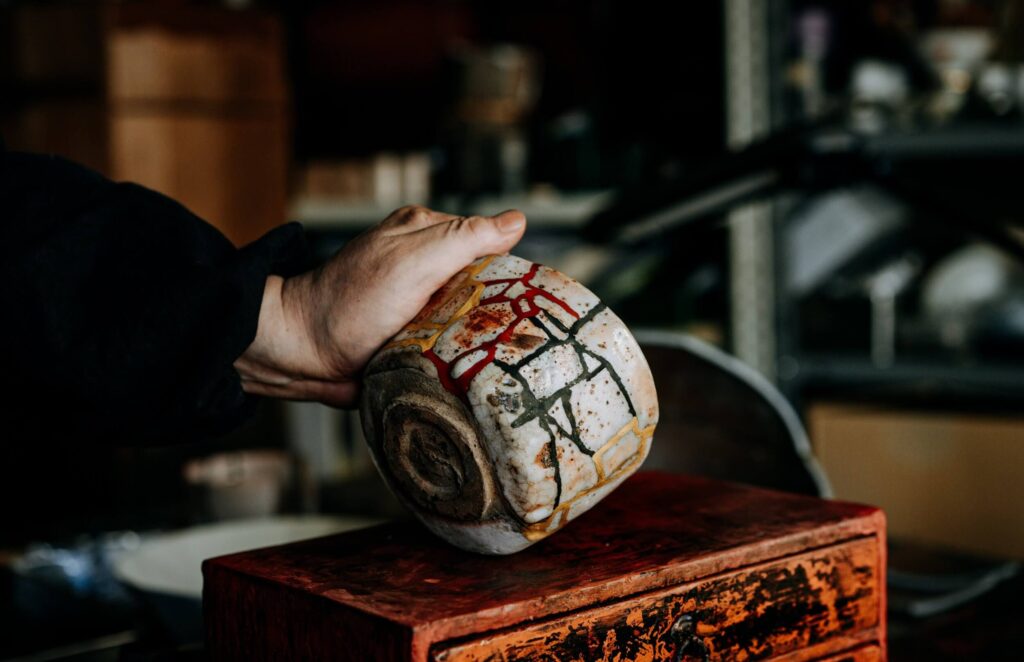I recently read an article detailing the Japanese custom of kintsugi, which is an artform of repairing broken pottery with a special-formed bonding lacquer mixed with either gold, silver, or platinum. The purpose of the process—central to the Japanese philosophy of wabi-sabi—is to highlight the imperfections and the history of the pottery, rather than simply repairing the damage so that it is no longer visible.
Writing in Architectural Digest, noted design expert Amy Azzarito, describes kintsugi as
“…a way of repair that celebrates the breakage as part of the object’s history, rather than as the end of the story. According to legend, the craft was invented when 15th-century shogun Ashikaga Yoshimasa broke his favorite Chinese tea bowl and sent it back to China to be repaired. The bowl was returned, fixed, but held together by ugly metal staples. The coarseness of the repair spurred the Japanese craftsman on to find a more elegant repair solution. Kintsugi arose as a way to not merely fix a broken object but to transform it into something beautiful.”
Reading about kintsugi for the first time, I could not help but see the parallels to my work as a psychotherapist and coach. By identifying perceived inadequacies—the brokenness and flaws that each of us have—and attempting to shine a light on them, we work to transform them from broken to beautiful.
One of the greatest joys I experience in my work is witnessing these transformations unfold. When clients identify traumas, feeling of intense negativity, and insecurities, they can begin the self-care that is the piecing together of their emotional foundation and reevaluating their mindsets. Rather than brush away or cover over those past issues or inadequacies, my clients come closer to their authentic selves when they engage in a process of emotional kintsugi.
All too often we feel that our flaws and past failures are too shameful to bear. Rather than looking at the cracks and blemishes on our soul as essential components of our life’s story, shame and embarrassment forces us to cover up these flaws and adapt an appearance of perfection. Or, we find ways to cover up our insecurities with self-medicating behaviors such as alcohol, shopping, or relationships to name a few. In my years of working with clients, what I have found to be the most confounding about this state of mind is that virtually every single one of us is far more forgiving of the flaws and shortcomings of others than we are of our own.
On a societal-level, we tend to find inspiration in the stories of those who have overcome failure and personal demons on their road to attaining success. Our culture is filled with stories of failure and despair that have been turned around to success and self-actualization. We often champion those in the public eye who have harnessed their will and fought their way out of poverty, addiction, and failure. Unfortunately though, we are much harder on ourselves.
We see it in the example of Robert Downey Jr., who went from multiple relapses and run-ins with the law to the highest paid actor in the world. We find inspiration in knowing that Steve Jobs was fired from the company he started only to return as CEO and give the world the iPhone.
JK Rowling was an unemployed, divorced single-mother living just above the poverty-line. Her Harry Potter manuscript was rejected by all 12 major publishing houses, prior to it being published by a small imprint for a modest advance (£1500). She went on to be the first writer in history to become a billionaire through the publishing books.
These stories of failure, negative experiences, and past trauma—like the golden lacquer in a kintsugi-worked piece of pottery—make our pasts more endearing and intriguing. When we began examining ourselves and addressing what is inhibiting our progress, we grab hold of those flaws and rework them into something else entirely. No longer scarred by shame and fear, we transform the negativity of the past into the beautiful tapestry of our more evolved and enlightened selves.
While this process of transformation is often beautiful and inspirational, it is by no means easy. Just as the most skilled practitioner of kintsugi cannot transform a piece of pottery until they identify the cracks, we too must do the work of spotting our cracks and flaws and endeavor to mend them into that which is life-affirming. This can only be achieved if we engage in the healing power of self-compassion and self-love; to be accepting of ourselves and courageous enough to evolve closer toward that person we desire to be.

Without love and compassion for ourselves, we may never mend the flaws that inhibit our personal growth, only conceal them from the outside world. When we acknowledge our pain, fear, and shame, we begin the process of emotional kintsugi; coming to terms with our past, acknowledging our insecurities and flaws, working through our issues, striving for growth, and becoming that beautiful and strong person we long to be…and are meant to be.
Through this process—one that I have witnessed many successfully undertake—our once battered and scared souls, like a kintsugi-mended vase, take on a more beautiful appearance. When we engage in the work of caring for ourselves, we enter a realm previously unimaginable.



